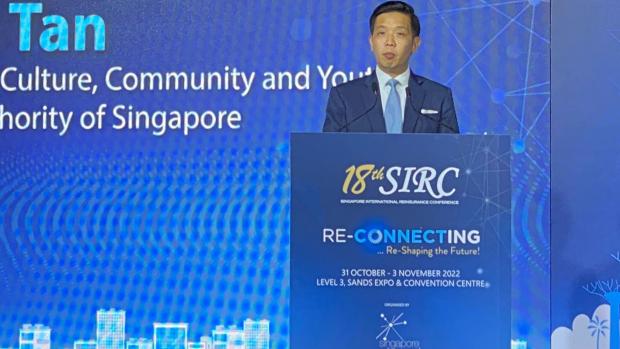‘Natural catastrophes continue to increase in frequency and severity, We need to strengthen the financial and societal resilience of vulnerable Communities’

(Full text of the opening remarks at the 18th Singapore International Reinsurance Conference, which inauguration today in Singapore.)
Distinguished Guests,
Ladies and Gentlemen,
Introduction
1. Thanks for inviting me to the Singapore International Reinsurance Conference 2022.
2. This year’s conference theme – “Reconnecting … Re-shaping the Future!” is timely. Good to see the SIRC return as an in-person conference after two years in virtual format. Good to re-connect, share ideas, and build meaningful partnerships.
Staying Resilient in Stormy Times
3. Senior Minister Tharman Shanmugaratnam delivered at the IMAS-Bloomberg investment conference, where he described our current economic and geopolitical situation as a “perfect long storm”. Economies, societies, and insurers, again face a new era of risk and fragility, just as they are trying to build back from rising claims and challenges arising from COVID-19.
a. The Russia-Ukraine war has resulted in food, commodity and energy shortages. Soaring inflation may push several economies towards recession. The global inflation rate is forecasted to rise to 7.5% by year end. [1]
b. Geopolitical and trade tensions are escalating. Countries are locking themselves into opposing and intractable positions. They are imposing restrictions on cross-border investments and supply chains. The margin of error is shrinking to the point where a small misstep may spark a massive conflict.
c. Meanwhile, the effects of climate change continue to play out, as natural catastrophes continue to increase in frequency and severity. Events such as Hurricane Ian, the Pakistan floods, and wildfires in Europe, are causing unprecedented catastrophic and economic damage, challenging current modelling assumptions.
4. Overall impact of these developments on the reinsurance industry has so far been mixed.
a. In the first half of this year alone, the global insurance industry estimated S$3.4 billion in collective losses and reserve charges related to the Russia-Ukraine war. [2]
b. High inflation is impacting health, motor and liability insurers. They are all facing higher claims that impact their profitability. Property and casualty reinsurance markets are hardening, prompted by both COVID-19 losses, and elevated catastrophe losses.
c. As central banks combat inflation, higher interest rates, however, will result in additional interest income for the investments of insurers. This will help insurers’ profitability in the medium-term. Prior to this, we must remember that insurers were challenged to generate sufficient returns to meet their liabilities in a low-interest environment.
Positive Outlook for the Reinsurance Industry in Asia
5. In Asia, the outlook for the reinsurance industry remains positive. Why? Asia continues to urbanise, Asia’s middle class is growing, Asia is consuming and producing more. In 2025, gross written premiums for life and non-life insurance are expected to grow to S$60 billion and S$20 billion respectively. [3] Correspondingly, more lives, wealth and assets will need protection.
6. These growth trends in Asia will benefit Singapore’s insurance, given our role as a key reinsurance centre for the region. The reinsurance industry has grown deep roots in Singapore over the past five years. During this period, total reinsurance premiums more than doubled, to reach S$20 billion in 2021.
7. Why have we been able to achieve this growth? Because of the industry’s vote of confidence in Singapore.
a. Since 2017, reinsurers have progressively developed their Asia-Pacific functions in Singapore to better support the region’s insurance markets and provide risk financing solutions. Reinsurers have also established strong partnerships with local and regional insurers, to produce more accurate risk assessments, support underwriting and pricing, and improve customer value propositions.
b. Singapore continues to be an important specialty insurance hub for Asia. We have started to grow our capabilities in newer lines of risk, in particular, cyber. While cyber insurance remains a nascent market in Asia as compared to Europe and North America, we are seeing more insurers establish cyber underwriting desks and resources for Asia in Singapore.
c. We have complemented our reinsurance market growth and debt capital markets capabilities by establishing Singapore as a domicile for Insurance-Linked Securities, or ILS. To date, Singapore has supported 22 ILS in the form of catastrophe bond issuances, by cedants across US and Asia-Pacific. In spite of the market uncertainties from COVID-19, the ILS deal flow reflects a growing familiarity and confidence in Singapore’s ILS regime.
Shaping the Future of Asia and Singapore’s Reinsurance Industry
8. Building on this growth in the last few years, Singapore’s reinsurance industry must continue its meaningful work in narrowing the region’s growing protection gap. A recent study by PwC estimates that the global protection gap could reach S$2.7 trillion by 2025, with Asia-Pacific accounting for almost half of all uninsured risk. [4] In this heightened risk environment, the role of reinsurance in partnering individuals, businesses and economies in reducing risk is all the more important.
9. To support the risk transfer needs of Asia amidst the heightened uncertainty, we must continue to grow Singapore’s capabilities in Asian insurance and risk transfer, and catalyse insurance risk advisory and risk transfer solutions for Asia. This vision is part of our broader Financial Services Industry Transformation Roadmap, or ITM 2025, that we launched last month. We aim to partner the reinsurance industry, and achieve our vision through three key strategies:
Growing Singapore as a Risk Financing Centre for Systemic and Structural Risks in Asia
10. First, grow Singapore as a risk financing centre for systemic and structural risks in Asia.
a. Singapore already has a good base of local and global life, health and retirement insurers and reinsurers. We will continue to build on our existing strengths in these areas of risk to support the growth of new revenue streams. These include risk advisory, strategy, and consulting capabilities.
b. Insurers are also adopting an ecosystem approach, by partnering firms from adjacent sectors, such as technology, wellness, and clinical sectors. This allows insurers to roll out more comprehensive programmes that ensure better risk outcomes.
i. A good example is AIA’s Amplify Health. In partnership with Discovery Group, AIA launched Amplify Health to combine healthcare tech, intellectual property and health expertise with AIA’s brand and distribution platform. It aims to make healthcare more convenient and affordable for consumers. Amplify Health features include policy administration, claims optimisation, disease management, health data analytics and more.
11. Beyond these risks, we will also embed deep capabilities in newer lines of risk, including pandemic, climate and cyber risks. The current challenges lie in a lack of established risk assessment and modelling data to support risk quantification, pricing and development of solutions.
a. The Global-Asia Insurance Partnership (GAIP), the centre of excellence supported by industry, academia and regulators, aims to address these data gaps. GAIP will focus on mortality projections and morbidity implications for COVID-19 as an endemic risk in Asia, developing a pandemic risk database, and exploring COVID-19’s impact on life and retirement insurance.
b. The insurance industry can also support the development of climate solutions in Singapore. Given the high risks from early-stage start-ups or tech for climate mitigation, insurers can support net-zero technology innovation through underwriting. This can help de-risk opportunities, and enable low carbon industries and companies to develop, implement and scale.
c. In parallel, MAS is also progressively integrating environmental risk into our supervisory framework and processes, at both the individual firm and system-wide levels. How so? We are:
i. Uplifting insurers’ environmental risk management practices through ongoing supervision and industry partnership;
ii. Encouraging the development of climate-related risk assessment capabilities, by featuring thematic climate scenarios in the industry-wide stress test; and
iii. Enhancing climate-related disclosure standards, to promote market transparency.
This is our first strategy – to build Singapore as a risk financing centre for systemic and structural risks in Asia.
Growing Singapore as a Hub for Alternative Risk Transfer Solutions in Asia
12. Our second strategy, under our Financial Sector Industry Transformation Map (ITM 2025), is to grow Singapore into a mature and diverse centre for alternative risk financing. This includes growing capabilities in risk pooling arrangements and in ILS, to complement our capabilities in reinsurance and fund management.
a. As natural catastrophes continue to increase in frequency and severity, we need to strengthen the financial and societal resilience of vulnerable communities. One way to do so is via risk pooling facilities, such as the Southeast Asia Disaster Risk Insurance Facility. SEADRIF is domiciled in Singapore, and is an ASEAN+3 initiative in partnership with the World Bank. It aims to provide ex-ante climate and disaster risk financing solutions for the region.
13. I mentioned ILS earlier, a form of alternative risk transfer solution that is gaining traction in Singapore.
a. We have had success in facilitating the issuances of catastrophe bonds. Our next aim is to allow cedants to be able to issue a broader spectrum of ILS. This includes sidecars, and collateralised reinsurance arrangements. We will look into the required regulatory, tax and legal infrastructure required to support these instruments and progressively implement them. As we explore the feasibility of these propositions, MAS would like to partner industry partners and experts to co-develop a comprehensive outcome together.
b. Asia’s ILS market has also shown good growth potential. We are thus looking to develop a vibrant ILS ecosystem in Asia to service Asian risks and clients, including structurer-arrangers, modelling firms, lawyers, advisors, loss reserve specialists, ILS fund managers and investors. MAS is keen to support firms in this space to build capabilities, networks and expertise.
14. So this is our second strategy, to grow Singapore a hub for Alternative Risk Transfer Solutions in Asia.
Transforming Insurers into Digital and Tech Champions
15. Our third strategy in ITM, is to help insurers transform into digital and tech champions. We will continue to support insurers in ramping up digitalisation, data analytics and innovation efforts.
a. The pandemic has sped up insurers’ digital transformation plans, especially in consumer-facing aspects such as distribution channels, customer service and claims. We want to continue this momentum and encourage insurers to take their digital transformation one step further – or rather, one step back, to update their mid-and back-office operations. This can be done through cloud-computing tools, that can provide insight into real-time data from multiple sources, such as artificial intelligence capabilities like machine learning. Insurers who can effectively use the cloud for business operations and analytics are best placed to navigate current and future challenges shaping the industry.
i. To support effective digital transformation, inter-operability within existing digital channels is important. One way to build an inter-connected system is to partner FinTech firms with the relevant technical expertise, to help produce better digital solutions.
ii. Insurers can tap on Singapore’s FinTech ecosystem to support their digital transformation. Our eco-system has grown in depth and breadth, offering a conducive environment for incumbents to partner, test and grow. Today, we house over 40 innovation labs by global institutions. We also have one of the region’s largest concentrations of InsurTechs, with about 80 firms located in Singapore.
16. I have just covered our three strategies to grow Singapore’s capabilities in Asian insurance and risk transfer, and catalyse insurance risk advisory and risk transfer solutions for Asia. They are:
a. Grow Singapore as a risk financing centre for systemic and structural risks in Asia;
b. Grow Singapore as a hub for alternative risk transfer solutions in Asia; and
c. Transforming Insurers into digital and tech champions.
Developing a Skilled and Adaptable Insurance Workforce
17. All these though, will come to nought if we don’t grow the most important resource – our people. Our ambitions plans will not become reality without a skilled and adaptable insurance workforce, comprising the best talent locally, and globally.
18. To cement Singapore as an attractive location for talent abroad, we changed our Employment Pass framework. We will introduce the Complementarity Assessment Framework(COMPASS) from September 2023. The refinements will improve the quality of Employment Passes, diversify the composition of our foreign workforce, and allow greater transparency to give businesses more certainty as they plan their headcount and manpower.
19. We will also continue to develop our local insurance workforce.
a. MAS, in partnership with the Institute of Banking & Finance, and insurance training agencies such as the Singapore College of Insurance, launched the Talent and Leaders in Finance Programme, or TLF. From 2021 to 2025, the Financial Sector Development Fund will provide S$400 million in funding to the TLF programme. This will help industry professionals take up good jobs and advance in their careers.
i. Some insurers, such as Income Insurance Limited, are partnering with polytechnics like Republic Polytechnic to offer internship programmes to students. We want to encourage more insurers hire more polytechnic graduates, through well-structured apprenticeship programmes. The TLF programme will support finance professionals at each stage of their careers. This includes entry-level polytechnic students, university graduates, and mid-career professionals looking to convert to finance roles.
b. We also want to embed deep specialist capabilities here in Singapore. For example, the Professional Liability Underwriting Society (PLUS) Singapore Committee will launch the region’s first Certification in Professional Liability and Directors & Officers Insurance. The content is derived from existing certification by PLUS in the United States and adapted for our Asian market. This will help develop underwriters, brokers, claims, legal, and risk management professionals to cater for the fast-growing professional liability and D&O insurance space.
Conclusion
20. As we continue to develop our insurance ecosystem, my hope is that Singapore can be a good launchpad for you to create meaningful solutions, for the broader economy and region. We’re all looking forward to reshaping the future, and making our vibrant Asian region more securely positioned for growth.
21. I wish you all a fruitful conference.
Thank you.
(Speech by Mr Alvin Tan, Minister of State, Ministry of Trade and Industry and Ministry of Culture, Community and Youth, and Board member of MAS, at the Singapore International Reinsurance Conference on 31 October 2022)














